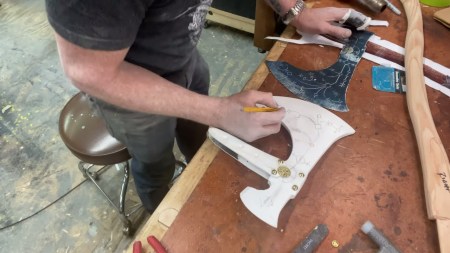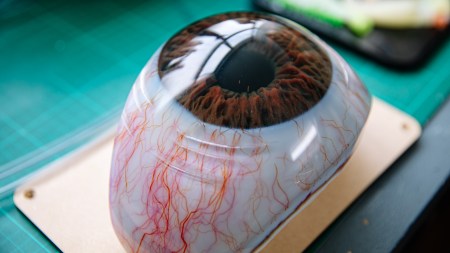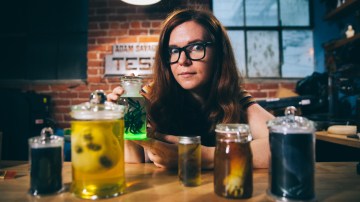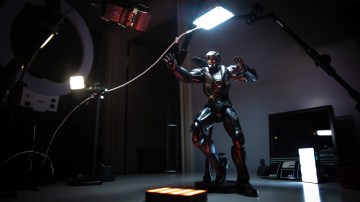Tested: The Best Ways to Sear a Steak!
Summer is here, and it’s time for some food science! We team up with Serious Eats‘ Managing Culinary Director J. Kenji López-Alt (and the author of James Beard Award-winning cookbook The Food Lab: Better Home Cooking Through Science) to test for an ideal way to sear a steak. Adam and Kenji discuss some misconceptions about steak searing, and test four searing methods at different temperatures.
Shot and edited by Adam Isaak
39 thoughts on “Tested: The Best Ways to Sear a Steak!”
Leave a Reply

One Day Builds
Adam Savage’s One Day Builds: Life-Size Velocirapt…
Adam embarks on one of his most ambitious builds yet: fulfil…

Show And Tell
Adam Savage’s King George Costume!
Adam recently completed a build of the royal St. Edwards cro…
All Eyes On Perserverance – This is Only a Test 58…
We get excited for the Perserverance rover Mars landing happening later today in this week's episode. Jeremy finally watches In and Of Itself, we get hyped for The Last of Us casting, and try to deciper the new Chevy Bolt announcements. Plus, Kishore gets a Pelaton and we wrack our brains around reverse engineering the source code to GTA …

Making
Adam Savage in Real Time: God of War Leviathan Axe…
Viewers often ask to see Adam working in real-time, so this …

One Day Builds
Mandalorian Blaster Prop Replica Kit Assembly!
Adam and Norm assemble a beautifully machined replica prop k…
House of MCU – This is Only a Test 586 – 2/11/21
The gang gets together to recap their favorite bits from this past weekend's Superb Owl, including the new camera tech used for the broadcast and the best chicken wing recipes. Kishore shares tips for streamlining your streaming services, and Will guests this week to dive into the mind-bending implications of the latest WandaVision episod…

One Day Builds
Adam Savage’s One Day Builds: Royal Crown of Engla…
One of the ways Adam has been getting through lockdown has b…

Making
Adam Savage Tests the AIR Active Filtration Helmet…
Adam unboxes and performs a quick test of this novel new hel…

Making
Weta Workshop’s 3D-Printed Giant Eyeballs!
When Adam visited Weta Workshop early last year, he stopped …

One Day Builds
Adam Savage’s One Day Builds: Wire Storage Solutio…
Adam tackles a shop shelf build that he's been putting off f…


























Hooray! More food based bits. 🙂
Ever since the omelette one I’ve followed Traci’s method whenever I do omelettes.
I’ve got a sous vide on it’s way to me at the moment *had to buy my own birthday present* so I’ll be trying a a lot of odd things in it. I doubt the BBQ will make an appearance as ever since I’ve bought a new Weber grill the weather here has been abysmal. Sorry UK… it’s all my fault.
Seriously impressed with the chimney method though. Will have to try that when I can get the Weber out. Damn, I’m hungry now.
We know Adam likes his coffee, so how about some more coffee nerdery?
Oh and… “I like to fiddle with my meat” That’s an entirely different video I suspect… Sounds like a return of Tested After Dark…
When Adam ran the “searzall”, to my eye, he ran the tool a little closer to the surface of the steak than did Kenji. I suspect the minute he spent searing was closer to a minute and a half on the other side. FWIW.
I’m not understanding why the grill would be hotter than the searzall but take longer to sear. Perhaps the temperature of the grill is not in fact hotter?
I’ve never tried using a chimney — now I will.
Thanks.
Whoo Kenji! Ever since your scientific cookies, I’ve been following your “recipes”. You really need a tv show, or at least a webshow. Such as a weekly segment on Tested.
My guess would be shorter time on the heat on the grill and less “contact” area. Versus the searzall which was 1-1.5 minutes close to the heat
Kenji here.
I think most likely the grill was not actually hotter than the Searzall, mainly because of timing (we let the coals get a little cooler than optimal). It’s also hard to really calculate such things easily at home because the best we can do with the tools I had was measure air temp or surface temp, which are not actually the most important factors when it comes to cooking. Heat flux across the cooking plane is what really matters, as that’s the measure of energy actually getting into that meat and would account for things like infrared heat xfer which an air temp thermometer would not account for. We were guessing/estimating at best as to actual cooking power.
FWIW, in past experience, the grill is typically faster than the searzall when the coals are properly stoked, especially with hardwood coals as opposed to the briquettes we were using during the shoot.
for the non-fahrenheit crowd: the searzall is in the low 300s, the grill low to high 300s, and the forge ~650 °C
also, this wonderful xkcd what-if has to be mentioned: from what height do you have to drop a steak for it to land cooked? https://what-if.xkcd.com/28/
Great video! Nice to see a comprehensive comparison done with food.
I’ve been using sous vide and a Searzall for a while now and it’s a match made in heaven. A great advantage to Sous Vide cooking is that you can’t over cook the steaks. One hour, two, three, pretty much the same. (Super long times like five hours or more won’t over cook the meat but you can start to get textural breakdown due to enzymes). The nice thing about the Searzall over the chimney grill is you don’t have to wait for the coals to heat, just pull the meat out of the sous vide bath, dry off and fire up the torch. And you can use the Searzall indoors under the stove hood. My preferred method is a combination of Searzall and a very hot cast iron pan with a little bit of peanut oil in it. Flipping every fifteen to twenty seconds or so.
This video is hilarious. No more two days ago I had to explain to a couple of friends that the best way to cook a steak was by placing it under a chimney (I saw an episode of “Good Eats” where this was done to a porterhouse steak). Now I can just show them this video showing the differences of the cooking styles/techniques.
Thank you for making it easier to show them this.
If I was going to do this, I’d just go with cast iron for the sear. Stick it directly on hardwood coals, let it get hot, and then you do your thing. I love the burner and I’ve used the chimney grill method, but I can do other things with the cast iron.
I love this kind of videos. Remind me early Tested.com with Will.
P.S. Production quality is amazing as always.
There’s another element to the crust that you didn’t really explore the details of. In a steakhouse they will put butter on the steak to add more of the char on the outside. My understanding is that the milk proteins in butter burn onto the outside, adding a thicker char without risking overcooking the interior meat.
I keep kosher, which means that I pay more for inferior steaks, and also have to employ a lot more lateral thinking in the grilling game. Lately I have been exploring using an egg white and corn starch solution (cribbed from a crispy Mongolian lamb recipe from the new york times) to get the same effect, minus the dairy. While I haven’t done a pepsi challenge yet, it seems like letting the sous vide steak absorb the egg white solution for about 20 minutes before I cast iron pan + searzall the meat to finish leads to a thicker crispier crust, without the heat starting to leak in an overcook the interior of the steak. I’d assume that grilling after marinating would yield a similar result.
Need more vids with Kenji. Highly enjoyable and a great result that I want to replicate. I have a Searzall and loves using it, but it would be a fun party taste test to compare the two.
Kenji, I liked you on America’s Test Kitchen and have been reading serious eats for a bit now. You and Adam are fun to watch together.
Had a nice dinner with my wife. Went to bed. Played this video… we’re hungry again.
I use a barrel as a grill, but when it fully filled with coals it becomes a chimney. My findings agree with this video. Chimneys are the best. But it might get too hot for some kinds of meat, chicken or turkey.
When I think the steaks are done. I do wrap them in aluminium foil.
To follow up on what Kenji mentioned re: heat flux.
Normally, we could calculate this by combining the heat capacity of the meat, the time to target temp, the surface area of the steak, and the weight loss pre/post cooking. However, since we’re just searing here and not fully cooking the meat – that would have been pretty inaccurate. We could establish the baseline flux for each cooking method as well by calculating BTU/area – but even figuring out BTUs would be tricky for the forge.
There are sensors to measure heat flux in food applications, but they are pretty expensive when I did the research for this shoot.
Lastly, for those who want to learn more about the chemistry of Maillard, C&EN provides a good and slightly technical overview: http://cen.acs.org/articles/90/i40/Maillard-Reaction-Turns-100.html
BTW the forge was simple powered with charcoal briquettes and a heat sink – forced air convection FTW!
Love to see you guys get back to some food stuff. I am an avid griller of steaks and found this very interesting. I also just bought the circulator that he was using. Really fun stuff guys I encourage more of this. I only have gas grill to finish on so I have to say you missed me on this but that’s ok. I still learned.
It would also be interesting to see a comparison of indoors steak cooking methods.
Pan/skillet, deep fryer, oven, etc.
This was a good, fun video in the spirit of summer cooking. They didn’t get all “sciencey” by carefully measuring all of the temps or with a control… they just had fun with it. I have had the Anova Precision Cooker ever since Kenji posted on it and I love it. It’s perfect for large groups and ensuring every single person gets a perfectly cooked portion. I have always finished in cast iron using Kenji’s oil/butter recommendation, or on my gas grill. But I will definitely try the chimney. Like they said: low-cost and something anyone can do. Good stuff guys. Hope to see more from you two in the future!
I am a horrible cook. Using the word “cook” is generous. I bought a Sansaire as soon as they became available after watching the Tested video on them years ago. It is the only way I cook meat.
I do not have a fancy Searzall (which I want to say Will and Norm used on a Whiskey Media Happy Hour), but I do have a little kitchen torch which works well enough for me.
The only thing I have trouble with sous viding is hamburgers. They always come out with a weird texture. 🙁
You skipped the one that AB did on his YouTube channel where he was cooking directly on the coals.
Also, the forge there looks like the one that The King of Random did.
What a great video, i really enjoy when my favorite channels teach me something outside their main theme.
Go Adam for still busting myths. ha ha. Can’t wait to start testing these methods out.
With the chimney method, I was shown to also use a large 18in metal salad bowl to give you a cooking chamber and it really boost the heat. One minute on a side with the cover, so one min, one min, then 30 sec, 30 sec for grill marks (If I remember right, ‘Good Eats’ is a great show) . Also the coals were raised so they were 1 in of space under the grate ( very hot ). This should give you a cooked steak in about 3 min or so. The metal bowl keeps the heat in so the other side is still cooking, getting it from both sides…( “I like to fiddle with my meat” , made me chuckle ). Adam just call Mr. Brown and he will tell you all about it. Hope this helps.
I would love to see something similar to this as a regular segment on tested! Kenji was quite interesting to listen too. 🙂
@kenjilopezalt Question for you: Almost all chefs hold their hand up to their mouth when they are tasting food, at least while being filmed. is it just in case it dribbles down your chin while talking, or is there another, conspiracy-ripe reason?
I doubt that the grills (isn’t that what those metal grids are called?) had the time to heat up, because you put them on the heat right before you put the steaks on, but aside from that, the chimney advice is fantastic news for those of us who don’t have the money to spend on a >800€ BBQ behemoth.
btw, really glad that this introduced me to seriouseats.com . Less glad that I’m now bingeing on mouthwatering articles while being on a diet. But at least it’s a Low-Carb, High-Fat diet 😉
I absolutely love my Anova immersion circulator and the Searzall attachment for my propane torch. I, like Kenji, went for the big boy because most of the burners they sell at bougie stores like Williams-Sonoma and Sur la Table don’t get hot enough and you end up with food that tastes more like the fuel because it combusts and spits out trace amounts of unspent fuel. I had a dinner party for 15 friends and cooked the steaks sous vide. At service, they were seared and ready all at the same time.
Usually it’s so people don’t see food being chewed while you talk, and so you don’t spit food all over the other person.
Great video, and very informative.
I have a question unrelated to steaks about this video though. Does anyone know what jacket Adam is wearing in this video? It looks great, and I’m interested in finding a similar one.
maybe give mayo a shot, plenty of egg in it to brown; I know restaurants use it for grilled cheese instead of butter.
So would you say that the myth that cooking on a hotter heat is “busted”?
SAY IT ADAM! SAY IT!
I miss mythbusters 🙁
I am going to go out and buy a Sous Vide doohicky now.
Great video! Kenji seems like a really swell guy.
The production made the atmosphere cosy and homely.
Since I use the Anavo, Searzall, chimney method myself, it was great to see them both find that one the best! For the past year I’ve been using an additional step, after I dry them off and before searing, I put a few dozen quick, shallow, cross-hatches across the face of both sides of my steaks to increase the surface area.
I would love to see what is the fastest way to get a reasonably cooked steak from frozen!
Adam: “The chimney comes out on top”.
Doesn’t it always?
Great video, more like this one please.
Nice work – good advice to us barbecuers – dry meat = best meat…
I have to say that with the fence in the background, I expected Wilson to put his 2 cents in!
Truly a shame that there is not ‘smellivision’…
I do it involuntarily just because I don’t want people to see what I’m chewing! My mom’s training, not restaurants 🙂
does anyone know about how much coal to put into the chimney? is 3/4 of the way up a sufficient amount or should it go all the way to the brim?
This was a great video. I am going to visit my Mom who doesn’t have a grill so a riffed on Kenji and Adam’s idea and came up with:
https://www.youtube.com/watch?v=ZOABQalhges
Tested Member: Zoltan
I love the food lab and its great to see more of cooking with science since good eats went off the air.
This was great. I was just a bit surprised that Adam wasn’t armed with an IR thermometer for surface temp readings, an instant-read thermometer to gauge baseline temps from the Sous Vide, then heat transfer from the sear, and a note pad. 🙂
Very cool and informative video, thanks!
I use the chimney method and I had a feeling it would be the winner.
I just want to remark that the duration of the sear was a bit apples and oranges when it comes to the searzall. The hot spot of the searzall is small and it take longer to cover the area of the steak